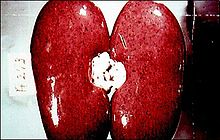Classical swine fever
| Classical swine fever | |
|---|---|
| Virus classification | |
| Group: | Group IV ((+)ssRNA)
|
| Family: | |
| Genus: | |
| Species: | Classical swine fever virus
|
Template:Confused2 Classical swine fever (CSF) or hog cholera (also sometimes called pig plague based on the German word Schweinepest) is a highly contagious disease of swine (Old World and New World pigs).[1]
Clinical signs
Swine fever causes fever, skin lesions, convulsions, and usually (particularly in young animals) death within 15 days.
The signs are indistinguishable from those of African swine fever.
Immunization
A small fraction of the infected pigs may survive and are rendered immune. Artificial immunization procedures were first developed by Marion Dorset.[2][3]
Epidemiology
The disease is endemic in much of Asia, Central and South America, and parts of Europe and Africa.[4] It was believed to have been eradicated in the United Kingdom by 1966 (according to the Department for Environment, Food & Rural Affairs), but an outbreak occurred in East Anglia in 2000. It was eradicated in the USA by 1978, according to the United States Department of Agriculture.
Other regions believed free of CSF include Australia, Canada (1962), Ireland, New Zealand, and Scandinavia.
Virus

The infectious agent responsible is a virus CSFV (previously called hog cholera virus) of the genus Pestivirus in the family Flaviviridae.[1][5] CSFV is closely related to the ruminant pestiviruses that cause bovine viral diarrhoea and border disease.[6]
The effect of different CSFV strains varies widely, leading to a wide range of clinical signs. Highly virulent strains correlate with acute, obvious disease and high mortality, including neurological signs and hemorrhages within the skin.
Less virulent strains can give rise to subacute or chronic infections that may escape detection, while still causing abortions and stillbirths. In these cases, herds in high-risk areas are usually serologically tested on a thorough statistical basis.
Infected piglets born to infected but subclinical sows help maintain the disease within a population. Other signs can include lethargy, fever, immunosuppression, chronic diarrhoea, and secondary respiratory infections. The incubation period of CSF ranges from 2 to 14 days, but clinical signs may not be apparent until after 2 to 3 weeks. Preventive state regulations usually assume 21 days as the outside limit of the incubation period. Animals with an acute infection can survive 2 to 3 months before their eventual death.
Eradicating CSF is problematic. Current programmes revolve around rapid detection, diagnosis, and slaughter. This may possibly be followed by emergency vaccination (ATCvet codes: QI09AA06 (WHO) for the inactivated viral vaccine, QI09AD04 (WHO) for the live vaccine). Vaccination is only used where the virus is widespread in the domestic pig population and/or in wild or feral pigs. In the latter case, a slaughter policy alone is usually impracticable. Possible sources for maintaining and introducing infection include the wide transport of pigs and pork products, as well as endemic CSF within wild boar and feral pig populations.
Diagnosis
- Direct immunofluorescence—detection of virus in histological edges
- Indirect immunofluorescence—detection of specific antibodies from sera
- ELISA
- Histology of the brain shows vasculoendothelial proliferation and perivascular cuffing (cuffing is highly suggestive when accompanied by other signs, but is not pathonomonic for the disease).
See also
References
- ^ a b Classical Swine Fever, The Center for Food Security and Public Health / The Institute for International Cooperation in Animal Biologics, College of Veterinary Medicine, Iowa State University, update September 2009.
- ^ [1], Marion Dorset: American Biochemist/Colleen Farrell 2002
- ^ [2], Marion Dorset/National Agricultural Hall of Fame
- ^ Arzt; et al. (2010). "Agricultural Diseases on the Move Early in the Third Millennium". Veterinary Pathology. 47: 15–27. doi:10.1177/0300985809354350.
{{cite journal}}: Explicit use of et al. in:|last1=(help) - ^ http://www.dpi.qld.gov.au/health/3945.html Archived 2003-08-22 at the Wayback Machine
- ^ Rumenapf and Thiel (2008). "Molecular Biology of Pestiviruses". Animal Viruses: Molecular Biology. Caister Academic Press. ISBN 978-1-904455-22-6.
{{cite book}}: External link in|chapterurl=|chapterurl=ignored (|chapter-url=suggested) (help)
External links
- CSF page of Pig Disease Information Centre (UK)
- Current status of Classical Swine Fever worldwide at OIE. WAHID Interface - OIE World Animal Health Information Database
- Disease card
- European Commission Animal Health & Welfare on CSF
- The Institute of Virology (Hannover) Reference Laboratory for CSF
- Department for Environment Food and Rurual Affairs (UK) on CSF
- International Veterinary Training talks about CSF
- The USDA's APHIS on CSF
- The Pig Site talks about swine fevers
- Vetgate CSF notes & resources
- Animal viruses
